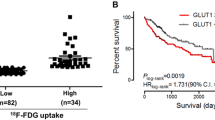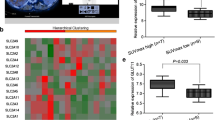Abstract
Purpose
18F-fluorodeoxyglucose (FDG) uptake on positron emission tomography (PET) scan has been found to reflect tumour aggressiveness and prognosis in various types of cancer. In this study, the gene expression profiles of hepatocellular carcinomas (HCCs) were evaluated to determine whether HCCs with high 18F-FDG uptake have more aggressive biological potential than those with low uptake.
Methods
Surgical specimens were obtained from ten patients with HCC (six males and four females, age range 38–68 years). The tumour samples were divided into two groups based on the 18F-FDG PET scan findings: high 18F-FDG uptake (n=4) and low 18F-FDG uptake (n=6).
Results
The pathological tumour grade was closely correlated with the 18F-FDG uptake pattern: HCCs with high 18F-FDG uptake were pathologically Edmondson-Steiner grade III, while those with low uptake were either grade II or grade II with a focal area of grade III. The total RNA was extracted from the frozen tissues of all HCCs (n=10) and adjacent non-cancerous tissue (n=7). The gene expression profiles were evaluated using an oligoDNA microarray. The HCCs with high 18F-FDG uptake showed increased expression of 11 genes—including vascular cell adhesion molecule-1, vinexin beta and core 1 UDP-galactose:N-acetylgalactosamine-alpha-R-beta 1,3-galactosyltransferase and the natural killer cell inhibitory receptor—compared to those with low uptake (p<0.005). Nine genes, including regulator of mitotic spindle assembly 1, grb2-related adaptor protein and beta-1,3-n-acetylglucosaminyltransferase, were repressed.
Conclusion
Gene expression is closely related to cell survival, cell-to-cell adhesion or cell spreading; therefore, HCCs with high 18F-FDG uptake appear to have more aggressive biological properties than those with low uptake.




Similar content being viewed by others
References
Tucker R, Coel M, Ko J, Morris P, Druger G, McGuian P. Impact of fluorine-18-fluorodeoxyglucose positron emission tomography on patient management: first year’s experience in a clinical center. J Clin Oncol 2001;19:2504–8.
Vansteenkiste JF, Stroobants SG, Dupont PJ, et al. Prognostic importance of the standardized uptake value on F-fluoro-2-deoxy-glucose-positron emission tomography scan in non-small-cell lung cancer. An analysis of 125 cases. J Clin Oncol 1999;17:3201–6.
Halfpenny W, Hain SF, Biassoni L, Maisey MN, Shernman JA, McGurk M. FDG-PET. A possible prognostic factor in head and neck cancer. Br J Cancer 2002;86:512–6.
Spaepen K, Stroobamts S, Dupont P, et al. Prognostic value of pretransplantation positron emission tomography using fluorine 18-fluorodeoxyglucose in patients with aggressive lymphoma treated with high-dose chemotherapy and stem cell transplantation. Blood 2003;102:53–9.
Nakata B, Chung YS, Nishimura S, et al. 18F-fluorodeoxyglucose positron emission tomography and the prognosis of patients with pancreatic adenocarcinoma. Cancer 1997;79:695–9.
Burt BM, Humm JL, Koody DA, et al. Using positron emission tomography with [18F]FDG to predict tumor behaviour in experimental colorectal cancer. Neoplasia 2001;3:189–195.
Miller TR, Pinkus E, Dehdashiti F, Grigsby PW. Improved prognostic value of 18F-FDG PET using a simple visual analysis of tumor characteristics in patients with cervical cancer. J Nucl Med 2003;44:192–7.
Downey RJ, Akhurst T, Ilson D, et al. Whole body 18FDG-PET and the response of esophageal cancer to induction therapy. Results of a prospective trial. J Clin Oncol 2003;21:428–32.
Trojan J, Schroeder O, Raedle J, et al. Fluorine-18 FDG positron emission tomography for imaging of hepatocellular carcinoma. Am J Gastroenterol 1999;94:3314–9.
Zimmerman RL, Burke M, Young NA, Solomides CC, Bibbo M. Diagnostic utility of Glut-1 and CA 15-3 in discriminating adenocarcinoma from hepatocellular carcinoma in liver tumors biopsied by fine-needle aspiration. Cancer 2002;96:53–7.
Torizuka T, Tamaki N, Inokuma T, et al. In vivo assessment of glucose metabolism in hepatocellular carcinoma with FDG-PET. J Nucl Med 1995;36:1811–7.
Shiomi S, Nishiguchi S, Ishizu H, et al. Usefulness of positron emission tomography with fluorine-18-fluorodeoxyglucose for predicting outcome in patients with hepatocellular carcinoma. Am J Gastroenterol 2001;96:1877–80.
Eisen MB, Spellman PT, Brown PO, Botstein D. Cluster analysis and display of genome-wide expression patterns. Proc Natl Acad Sci U S A 1998;95:14863–8.
Schafer DF, Sorrell M. Hepatocellular carcinoma. Lancet 1999;353:1253–7.
Okabe H, Satoh S, Furukawa Y, et al. Involvement of PEG10 in human hepatocellular carcinogenesis through interaction with SIAH1. Cancer Res 2003;63:3043–8.
Naiki T, Nagaki M, Shidoji Y, et al. Analysis of gene expression profile induced by hepatocyte nuclear factor 4α in hepatoma cells using oligonucleotide microarray. J Biol Chem 2002;277:14011–9.
Okabe H, Satoh S, Kato T, et al. Genome-wide analysis of gene expression in human hepatocellular carcinomas using cDNA microarray: identification of genes involved in viral carcinogenesis and tumor progression. Cancer Res 2001;61:2129–37.
Smith MW, Yue ZN, Geiss GK, et al. Identification of novel tumor markers in hepatitis C virus-associated hepatocellular carcinoma. Cancer Res 2003;63:859–64.
Iizuka N, Oka M, Yamata-Okabe H, et al. Oligonucleotide microarray for prediction of early intrahepatic recurrence of hepatocellular carcinoma after curative resection. Lancet 2003;361:923–9.
Iizuka N, Oka M, Yamata-Okabe H, et al. Differential gene expression in distinct virologic types of hepatocellular carcinoma: association with liver cirrhosis. Oncogene 2003;22:3007–14.
Xu XR, Huang J, Xu ZG, et al. Insight into hepatocellular carcinogenesis at transcriptome level by comparing gene expression profiles of hepatocellular carcinoma with those of corresponding noncancerous liver. Proc Natl Acad Sci U S A 2001;98:15089–94.
Iizuka N, Oka M, Yamata-Okabe H, et al. Comparison of gene expression profiles between hepatitis B virus- and hepatitis C virus-infected hepatocellular carcinoma by oligonucleotide microarray data on the basis of a supervised learning method. Cancer Res 2002;62:3939–44.
Kitakata H, Nemoto-Sasaki Y, Takahashi Y, Kondo T, Mai M, Mukaida N. Essential roles of tumor necrosis factor receptor p55 in liver metastasis of intrasplenic administration of colon 26 cells. Cancer Res 2002;62:6682–7.
Mendoza L, Carrascal T, De Luca M, Fuentes AM, Salado C, Blanco J, Vidal-Vanaclocha F. Hydrogen peroxide mediates vascular cell adhesion molecule-1 expression from interleukin-18-activated hepatic sinusoidal endothelium: implications for circulating cancer cell arrest in the murine liver. Hepatology 2001;34:298–310.
Kioka N, Sakata S, Kawauchi T, et al. Vinexin: a novel vinculin-binding protein with multiple SH3 domains enhances actin cytoskeletal organization. J Cell Biol 1999;144:59–69.
Brockhausen I. Pathways of O-glycan biosynthesis in cancer cells. Biochim Biophys Acta 1999;1473:67–95.
Kudo T, Iwai T, Kubota T, et al. Molecular cloning and characterization of a novel UDP-Gal:GalNAcα peptide β1,3-galactosyltransferase (C1Gal-T2), an enzyme synthesizing a core 1 structure of O-glycan. J Biol Chem 2002;277:47724–31.
Kataoka K, Huh NH. A novel β1,3-N-acetylglucosaminyltransferase involved in invasion of cancer cells as assayed in vitro. Biochem Biophys Res Commun 2002;294:843–8.
Moser JM, Gibbs J, Jensen PE, Lukacher AE. CD94–NKG2A receptors regulate antiviral CD8+ T cell responses. Nat Immunol 2002;3:189–195.
Vetter CS, Straten PT, Terheyden P, Zeuthen J, Brocker EB, Becker JC. Expression of CD94/NKG2 subtypes on tumor-infiltrating lymphocytes in primary and metastatic melanoma. J Invest Dermatol 2000;114:941–7.
Cassimeris L, Skibbens RV. Regulated assembly of the mitotic spindle: a perspective from two ends. Curr Issues Mol Biol 2003;5(3):99–112.
Leopold L, Heidi K, Cuong H, et al. Grap-2, a novel RET binding protein, is involved in RET mitogenic signaling. Oncogene 2003;22:5362–6.
Iavarone M, Lampertico P, Seletti C, et al. The clinical and pathogenetic significance of estrogen receptor-β expression in chronic liver diseases and liver carcinoma. Cancer 2003;98:529–34.
Villa E, Grottola A, Colantoni A et al. Hepatocellular carcinoma, role of estrogen receptors in the liver. Ann N Y Acad Sci 2002;963:37–45.
Lindberg MK, Moverare S, Skrtic S, et al. Estrogen receptor (ER)-β reduces ERα-regulated gene transcription, supporting a “Ying Yang” relationship between ERα and ERβ in mice. Mol Endocrinol 2003;17:203–8.
Chow PKH, Tai BC, Tan CK, et al. High-dose tamoxifen in the treatment of inoperable hepatocellular carcinoma: a multicenter randomized controlled trial. Hepatology 2002;36:1221–6.
Schmitt-Graff A, Ertelt V, Allgaier HS, et al. Cellular retinal-binding protein-1 in hepatocellular carcinoma correlated with β-catenin, Ki-67 index, and patient survival. Hepatology 2003;38:470–80.
Wirths O, Waha A, Weggen S, et al. Overexpression of human Dickkopf-1, an antagonist of wingless/Wnt signaling, in human hepatoblastomas and Wilms’ tumors. Lab Invest 2003;83:429–34.
Shou J, Ali-Osman F, Multani AS, Pathak S, Fedi P, Srivenugopal KS. Human Dkk-1, a gene encoding a Wnt antagonist, responds to DNA damage and its overexpression sensitizes brain tumor cells to apoptosis following alkylation damage of DNA. Oncogene 2002;21:878–89.
Acknowledgements
The authors thank Sang-Ho Park, PhD and Eun-Sung Park, PhD at Macrogen Co. for their excellent technical assistance in the microarray analysis. This work was supported by a grant from the Korean National Cancer Control Program, Ministry of Health & Welfare (02-1-2-0590), the BK 21 project in Medical Science, Yonsei University College of Medicine, and the Nuclear R&D Program from the Ministry of Science & Technology in Korea.
Author information
Authors and Affiliations
Corresponding author
Rights and permissions
About this article
Cite this article
Lee, J.D., Yun, M., Lee, J.M. et al. Analysis of gene expression profiles of hepatocellular carcinomas with regard to 18F-fluorodeoxyglucose uptake pattern on positron emission tomography. Eur J Nucl Med Mol Imaging 31, 1621–1630 (2004). https://doi.org/10.1007/s00259-004-1602-1
Received:
Accepted:
Published:
Issue Date:
DOI: https://doi.org/10.1007/s00259-004-1602-1




